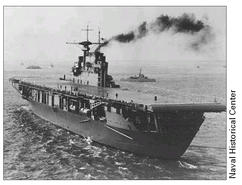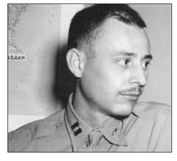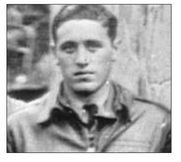War Stories II (16 page)
Authors: Oliver L. North

Â
USS
Hornet
. Doolittle's Raiders launched from her deck in April 1942.
Hornet
. Doolittle's Raiders launched from her deck in April 1942.

Doolittle began his search for aircrews by first asking the Army Air Corps to identify the best-trained B-25 unit. The 17th Bombardment Group, stationed at Pendleton Field, Oregon, was selected, and in early February 1942, the entire group was ordered to fly to Columbia, South Carolina, where they would be away from any possible enemy spies or collaborators. Once they arrived in South Carolina, Doolittle asked for volunteers to accompany him on a top-secret mission he described only as “dangerous.” One hundred and forty-nine men volunteered, from which he selected ninety-nine.
Doolittle divided the men into twenty five-man flight crews, and dispatched them to Eglin Field, on the Gulf Coast of Florida, where they spent most of March practicing takeoffs from a 500-foot section of runway to approximate what it would be like to launch from a carrier deck. They also practiced low-level bombing runs by flying just above the whitecaps in the Gulf of Mexico.
During this Florida “shakedown” period, Doolittle had each B-25 retrofitted with extra 225-gallon fuel tanks in the bomb bay and in the crawlway behind the cockpit. Sixty-gallon fuel tanks replaced guns in the bottom turrets, so radios, batteries, and even the tail guns were removed. Broomsticks, painted black, were inserted in the turrets and blisters in hopes that any pursuing Japanese fighter planes would mistake them for real machine guns and think twice about getting too close. Doolittle also used this time to trim down his volunteers to the seventy-nine who would accompany him on the mission.
While the aircraft were being modified, Doolittle sent two lieutenants, Thomas Griffin and Davey Jones, to Washington, D.C., to learn all they could about the enemy from Army Air Corps intelligence. Without divulging their mission, Griffin and Jones collected maps and photographs of five different Japanese cities. Doolittle wanted American bombs to land on at least five different locations so that that the enemy propaganda machine couldn't hide the facts of the attacks from the Japanese people.
Twenty-six-year-old Dick Cole was among those who gave me their account of the mission. He was Doolittle's copilot, and the plane's navigator was Lieutenant Henry Potter, a twenty-two-year-old from South Dakota.
Lieutenant Bobby Hite, a farm boy from Texas, had planned to become an agricultural teacher but dropped out of college after three years and enlisted in the Army Air Corps. As a twenty-one-year-old copilot, he flew in the same B-25 as Corporal Jacob (“Jake”) DeShazer, their bombardier.

LIEUTENANT ROBERT HITE, US ARMY
Secret Training Site
Eglin Field, Florida
15 February 1942
Secret Training Site
Eglin Field, Florida
15 February 1942

We didn't know at the time that we were going to Japan. Jimmy said it would be very dangerous, but he couldn't tell us more. Everybody speculated that we were going to be sent to Europe. We just really didn't have a
clue. Nobody mentioned an aircraft carrier, but the whole group volunteered anyway.
clue. Nobody mentioned an aircraft carrier, but the whole group volunteered anyway.
We were ready. We wanted to go with Jimmy Doolittle wherever he went. And I think, in our hearts and minds, we had the attitude “we can do it.”

LIEUTENANT HENRY (“HANK”) POTTER,
US ARMY
Secret Training Site
Eglin Field, Florida
15 February 1942
US ARMY
Secret Training Site
Eglin Field, Florida
15 February 1942

When we got to Columbia, South Carolina, Doolittle gathered the flight crews together in a hangar and briefed us, stating, “We're gonna need volunteers for a dangerous mission that will be of great importance to the American war effort.” Nobody could figure out where he wanted us to go or what he wanted us to do when we got there, but if Jimmy Doolittle was going, we wanted to be there.
He sent us to Eglin Field in Florida, where the pilots learned how to take off at short distances and the rest of us got the additional training in navigation, bombing, and firing machine guns. I don't think that any one of us had any lack of confidence that we'd be able to make it. After all, we were flying with the premier pilot in the Air Corps at that time. If he couldn't do it, it wasn't going to be done.
 USS HORNET
USS HORNETNAVY TASK FORCE 16.2
SAN FRANCISCO BAY
1 APRIL 1942
SAN FRANCISCO BAY
1 APRIL 1942
Finally, after more than a month of arduous training exercises and flight maneuvers, the planes and men were ready. Doolittle sent the armada of B-25s from Eglin Field to McClelland Field, not far from Sacramento,
California. From there, on 22 March, the B-25s flew to Alameda Naval Air Station near Oakland, on San Francisco Bay.
California. From there, on 22 March, the B-25s flew to Alameda Naval Air Station near Oakland, on San Francisco Bay.
During the nearly 3,000-mile trip to California, Doolittle had told his high-spirited aircrews to practice low-level flying. The young daredevils flew at practically cornstalk level, skimming over farmhouses, “hot-dogging” it across the country. They flew down through the Grand Canyon, and up and down the Sacramento Valley at an elevation of ten feet above ground level, sending farmers and fruit pickers scurrying for cover.
April Fool's Day, 1942, was the date picked for having everything ready. The following morning, the carrier and its seven escort ships, designated as Task Force 16.2, sailed from San Francisco Bay. Once well out to sea, the skipper of the
Hornet,
Captain Marc Mitscher, with Doolittle beside him, announced over the ship's PA system their objectiveâuntil now top secret information. The captains of the escorts did the same, telling all hands: “Now hear thisâthis task force is going to Japan.” Those who were there remember the cheering that reverberated across the decks.
Hornet,
Captain Marc Mitscher, with Doolittle beside him, announced over the ship's PA system their objectiveâuntil now top secret information. The captains of the escorts did the same, telling all hands: “Now hear thisâthis task force is going to Japan.” Those who were there remember the cheering that reverberated across the decks.
Northwest of Hawaii, the
Hornet
and her escorts rendezvoused with Task Force 16.1, consisting of the carrier USS
Enterprise
, with Admiral Halsey aboard, and eight escorts. Together, the seventeen ships raced northwest across the Pacific, heading for the spot in the ocean 412 miles from the Japanese coast that Doolittle and the Navy planners had chosen as a takeoff point for the B-25s.
Hornet
and her escorts rendezvoused with Task Force 16.1, consisting of the carrier USS
Enterprise
, with Admiral Halsey aboard, and eight escorts. Together, the seventeen ships raced northwest across the Pacific, heading for the spot in the ocean 412 miles from the Japanese coast that Doolittle and the Navy planners had chosen as a takeoff point for the B-25s.
It was, for this high-risk mission, a sensible plan. U.S. naval intelligence officers knew that the Japanese had positioned picket ships along a perimeter 400 miles from their homeland. The warlords in Tokyo had done the mathâthey figured that the Americans would have to be no more than 300 miles from Japan in order to carry out any kind of attack with carrier-based aircraft. The U.S. Navy code-breakers also knew from intercepts of Japanese communications that the 26th Air Flotilla, with more than sixty bombers on alert, could take off on short notice and attack any U.S. vessel that the pickets sighted as far as 600 miles outâwell before carrier-based task forces could launch an air attack on Japan.
Halsey's fleet steamed west maintaining total radio silence, hoping that the 10,000-man task force could make it to within 412 miles of the Japanese coastline without being detected. Doolittle's aircraft needed to be close enough to hit their targets and still have enough fuel to make it 800 more miles to recovery fields in China. After launching the bombers, the task force ships would turn and race south, hoping to be out of the area and beyond the range of any Japanese aircraft by the time they arrived at the launch site.
It was a superb planâon paper. But the fliers were taking a huge risk. So were the aircraft carriers and their escorts. The
Hornet
and the
Enterprise
made up half of the entire carrier strength of the U.S. Pacific Fleet. If they were discovered and sunk by the Japanese, it could take years for America to rebound, rebuild its naval forces, and deal with the Imperial Navy.
Hornet
and the
Enterprise
made up half of the entire carrier strength of the U.S. Pacific Fleet. If they were discovered and sunk by the Japanese, it could take years for America to rebound, rebuild its naval forces, and deal with the Imperial Navy.
Aboard the
Hornet
, the Army aircrews were kept busy rehearsing the mission and working on the planesâcritical parts were even delivered to them by blimp. They had to memorize maps and targets, listen to intelligence briefings, learn about Japan's cities and culture, and review their options after the bombing runs.
Hornet
, the Army aircrews were kept busy rehearsing the mission and working on the planesâcritical parts were even delivered to them by blimp. They had to memorize maps and targets, listen to intelligence briefings, learn about Japan's cities and culture, and review their options after the bombing runs.
Doolittle hoped that he had thought of everything. His plan called for Chinese guerrillas, under Chiang Kai-shek, to place radio beacons to lead the B-25s to safe landing fields in China. Still, his greatest anxiety was having enough fuel to reach them.
Other books
torg 02 - The Dark Realm by Douglas Kaufman
Casanova's Women by Judith Summers
Dawn of the Aspects: Part II by Richard A. Knaak
Step Brother by Jayna King
The Hardest Fall (Roadmap to Your Heart Book 3) by Christina Lee
The Drowning Girls by Paula Treick Deboard
The English Village Explained: Britain’s Living History by Yorke, Trevor
George's Cosmic Treasure Hunt by Lucy Hawking
